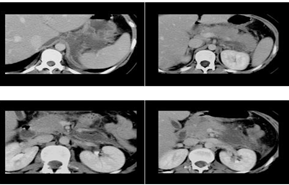Epidemiology, incidence, etiology, complications and outcome of Acute Pancreatitis in Kashmiri Population: A retrospective hospital based single centre study.
Abstract
Introduction: Acute pancreatitis is an inflammatory disease of the pancreas. It can be initiated by several factors, including gallstones, alcohol, trauma, infections and hereditary factors. About 75% of pancreatitis is caused by gallstones or alcohol. According to the physical examination, radiological findings and laboratory results the etiology of the acute pancreatitis is diagnosed as biliary or non-biliary.
Aims and Objectives: The present study aimed to study the clinical profile (incidence, etiology and outcome) of Kashmiri patients with acute pancreatitis.
Material and Methods: This was a hospital based retrospective study conducted in Srinagar for a period of 2 years w.e.f. September 2017 to September 2019 on 650 patients of all age groups with clinical/Laboratory/imaging findings suggestive of acute pancreatitis.
Results: Our data revealed gallstone as most common etiological agent followed by idiopathic acute pancreatitis. Mild, moderately severe acute pancreatitis constitutes 48.61%, 24.61% and 26.76% of patients respectively. There is statistically significant association between high body mass index >25 Kg/m2, waist circumference >100 cm, high blood sugar >200 mg /dl, hematocrit >44, CRP >150 mg/d and worsening of acute pancreatitis.
Conclusion: The present study concluded that the Kashmir valley has increased number of cases of acute pancreatitis in recent years which is one of the major causes of admission in gastroenterology ward.
Key words: Acute Pancreatitis, Inflammatory disease, Gallstone, Clinical profile and Severity of pancreatitis.
Downloads
References
Ilhan M, Alis H. Acute Biliary Pancreatitis. In: Rodrigo L. (Editor) Acute Pancreatitis. Chacute pancreatitister 1, Rijeka, Croatia, 2011, PP 1.
Eland IA, Sturkenboom MJ, Wilson JH, Stricker BH. Incidence and mortality of acute pancreatitis between 1985 and 1995. Scand J Gastroenterol 2000; 35: 110-16.
Chen DB, Wang L, Wang PH, et al. Insulin-like growth factor I retards acute pancreatitisoptotic signaling induced by ethanol in cardiomyocytes. Life Sci 2000; 67: 1683-93.
Tenner S, Baillie J, DeWitt J, Vege SS; American College of Gastroenterology. American College of Gastroenterology guideline: management of acute pancreatitis. Am J Gastroenterol 2013; 108(9): 1400-15.
Balthazar EJ, Ranson JHC, Naidich DP, et al. Acute-pancreatitis—prognostic value of CT. Radiology 1985; 3: 767–72.
Khanna AK, Meher S, Prakash S, Tiwary SJ, Singh U, Srivastava A et al. Comparison of Ranson, Glasgow, MOSS, SIRS, BISAP, APACHE-II, CTSI Scores, IL- 6, CRP, and Procalcitonin in Predicting Severity, Organ Failure, Pancreatic Necrosis, and Mortality in Acute Pancreatitis. HPB Surgery. 2013;367581:1-10.
Chand P, Singh R, Singh DP, Rani N. Evaluation of the outcome of acute pancreatitis by Ranson’s criteria and modified CT severity index. International Journal of Contemporary Medicine Surgery and Radiology. 2017; 2(2):58-61.
Balthazar EJ, Ranson JHC, Naidich DP, et al. Acute-pancreatitis—prognostic value of CT. Radiology 1985; 3: 767–72.
Nesvaderani M, Eslick GD, Vagg D, Faraj S, Cox MR. Epidemiology, aetiology and outcomes of acute pancreatitis: A retrospective cohort study. Int J Surg. 2015; 23(Pt A):68-74.
Vidarsdottir H, Moller PH, Vidarsdottir H, Thorarinsdottir H, Bjornsson ES. Acute pancreatitis. European Journal of Gastroenterology and Hepatology 2013;25(9):1068–75.
Webster PD. Pathophysiology and management of acute pancreatitis. Hosp Prac. 1974; 56-66.
Shah SSH, Ansari MA, Ali S. Early prediction of severity and outcome of acute severe pancreatitis. Pak J Med. Sci. 2009; 25: 619-623.
Jin Z, Xu L, Wang X and Yang D. Risk factors for worsening of acute pancreatitis in patients admitted with mild acute pancreatitis. International Journal of Science and Research (IJSR). 2016; Volume 5, Issue 7.
Jain S, Mahacute pancreatitisatra SJ, Gupta S, Garg MK. Infected pancreatic necrosis due to multi-drug resistant organism and persistent organ failure predict mortality in acute pancreatitis. Clinical and Transnational Gastroenterology 2018; 9: 190.
Singh VK. Prospective Evaluation of the Bedside Index for Severity in Acute Pancreatitis Score in Assessing Mortality and Intermediate Markers of Severity in Acute Pancreatitis. Am J Gastroenterol 2009; 104:966–971.
Zerem E, Imamovic G, Susic A, Haracic B. Step-up acute pancreatitisproach to infected necrotizing pancreatitis: a 20 year experience of percutaneous drainage in a single center. Dig Liver is 2011; 43(6): 478-83.



























